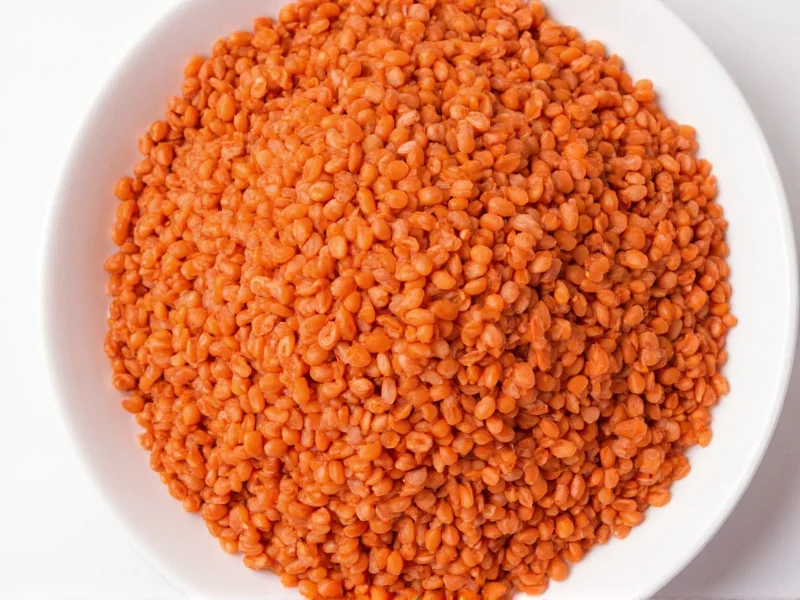When evaluating red lentil nutrition facts, these vibrant legumes stand out as a nutritional powerhouse among plant-based proteins. Unlike other lentil varieties that maintain their shape when cooked, red lentils break down quickly, making them ideal for soups, stews, and dals. This unique cooking property doesn't diminish their impressive nutritional profile, which supports multiple aspects of health from cardiovascular function to blood sugar regulation.
Nutritional Composition of Red Lentils
Understanding the complete red lentils nutritional value per 100g helps appreciate why nutritionists consistently recommend them. A single cooked cup (198g) delivers substantial nutrients while remaining low in fat and naturally gluten-free. The protein content rivals many animal-based sources when considering amino acid completeness in a plant-based context.
| Nutrient | Per Cooked Cup (198g) | % Daily Value |
|---|---|---|
| Calories | 230 | 12% |
| Protein | 18g | 36% |
| Dietary Fiber | 15.6g | 56% |
| Folate (B9) | 358mcg | 90% |
| Iron | 6.6mg | 37% |
| Manganese | 1.3mg | 57% |
| Phosphorus | 356mg | 28% |
| Carbohydrates | 39.9g | - |
| Sugars | 3.8g | - |
Comparative Analysis: Red Lentils vs Other Varieties
When examining red lentils vs green lentils nutrition, several key differences emerge. Red lentils cook faster and have a slightly higher carbohydrate content but comparable protein levels. Their distinctive orange color indicates different phytonutrient profiles compared to green or black lentils.
| Nutrient Comparison | Red Lentils (Cooked) | Green Lentils (Cooked) | Black Lentils (Cooked) |
|---|---|---|---|
| Protein (per cup) | 18g | 18g | 26g |
| Fiber (per cup) | 15.6g | 15.6g | 15g |
| Folate (per cup) | 358mcg | 358mcg | 25% DV |
| Iron (per cup) | 6.6mg | 6.6mg | 10.8mg |
| Calories (per cup) | 230 | 230 | 268 |
| Cooking Time | 15-20 minutes | 25-30 minutes | 25-30 minutes |
Health Benefits Supported by Nutrition Science
The health benefits of red lentils extend beyond basic nutrition. Their unique composition offers specific advantages for various health concerns:
Cardiovascular Protection
Red lentils contain significant amounts of potassium (731mg per cup) and magnesium (71mg per cup), both essential for blood pressure regulation. The soluble fiber content helps reduce LDL cholesterol levels by binding to bile acids in the digestive tract. Research published in the American Journal of Clinical Nutrition indicates that regular legume consumption correlates with a 22% lower risk of coronary heart disease.
Blood Sugar Management
With a low glycemic index of 26, red lentils provide sustained energy release. The combination of protein and fiber creates a slow digestion process that prevents blood sugar spikes. A 2020 study in Nutrients demonstrated that participants who consumed lentils with rice experienced 20-35% lower post-meal glucose levels compared to those eating rice alone. This makes red lentils for diabetics an excellent dietary choice.
Digestive Health Enhancement
The 15.6g of dietary fiber per cooked cup (56% of daily needs) supports healthy gut microbiota. Unlike some high-fiber foods that cause discomfort, red lentils contain predominantly soluble fiber, which is gentler on the digestive system. This fiber profile promotes regular bowel movements while feeding beneficial gut bacteria that produce short-chain fatty acids essential for colon health.
Maximizing Nutritional Value
To get the most from red lentil nutrition facts cooked vs uncooked, consider these evidence-based preparation tips:
- Soaking isn't necessary for red lentils due to their thin skins, but a 2-4 hour soak can reduce cooking time and improve digestibility
- Add acidic ingredients like tomatoes or lemon juice during cooking to enhance iron absorption
- Pair with vitamin C-rich foods to increase non-heme iron bioavailability by up to 400%
- Avoid overcooking to preserve water-soluble B vitamins
- Store cooked lentils in airtight containers for up to 5 days to maintain nutrient integrity
Practical Dietary Integration
Incorporating red lentils into your diet offers flexibility across various eating patterns. Their mild, slightly sweet flavor makes them adaptable to numerous cuisines. For those exploring red lentils for weight loss, their high protein and fiber content creates significant satiety with relatively few calories. A single cup provides 36% of daily protein needs while delivering substantial volume to promote fullness.
Vegans and vegetarians particularly benefit from the complete amino acid profile when combined with grains. The iron content (6.6mg per cup) addresses a common nutritional concern in plant-based diets, though absorption optimization through vitamin C pairing remains important.
Nutritional Considerations and Myths
Several misconceptions surround red lentil nutrition. While they contain phytic acid that can inhibit mineral absorption, proper preparation methods significantly reduce this effect. The notion that how much protein in red lentils is insufficient for muscle building is inaccurate—when consumed as part of a varied plant-based diet, they contribute meaningfully to protein requirements.
Unlike some legumes, red lentils contain minimal oligosaccharides, the carbohydrates responsible for gas production, making them more digestible than beans for many people. Their naturally low fat content (0.8g per cup) makes them suitable for heart-healthy eating patterns without compromising nutritional density.











 浙公网安备
33010002000092号
浙公网安备
33010002000092号 浙B2-20120091-4
浙B2-20120091-4